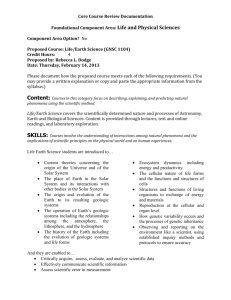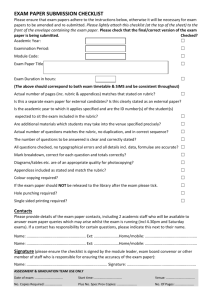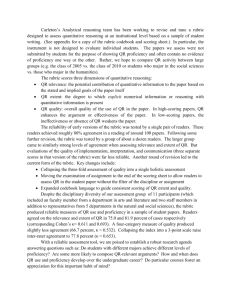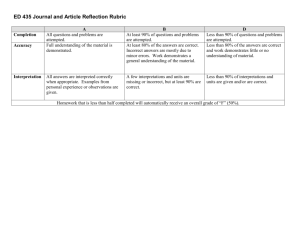Goal 1 and 2 Review Forms
advertisement
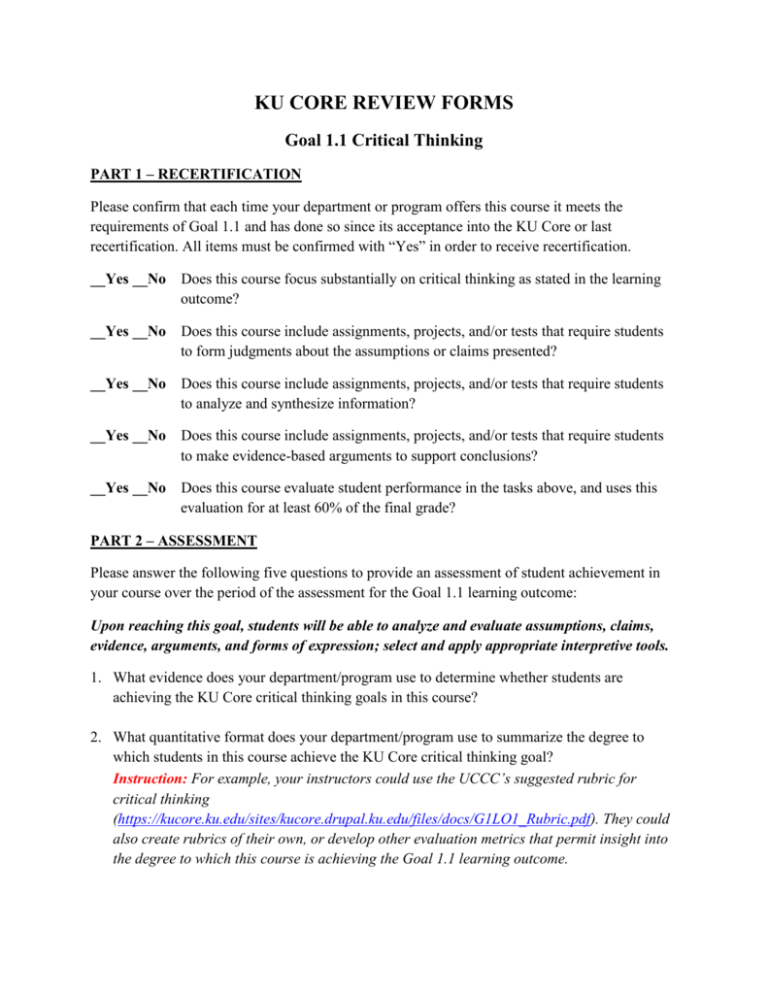
KU CORE REVIEW FORMS Goal 1.1 Critical Thinking PART 1 – RECERTIFICATION Please confirm that each time your department or program offers this course it meets the requirements of Goal 1.1 and has done so since its acceptance into the KU Core or last recertification. All items must be confirmed with “Yes” in order to receive recertification. __Yes __No Does this course focus substantially on critical thinking as stated in the learning outcome? __Yes __No Does this course include assignments, projects, and/or tests that require students to form judgments about the assumptions or claims presented? __Yes __No Does this course include assignments, projects, and/or tests that require students to analyze and synthesize information? __Yes __No Does this course include assignments, projects, and/or tests that require students to make evidence-based arguments to support conclusions? __Yes __No Does this course evaluate student performance in the tasks above, and uses this evaluation for at least 60% of the final grade? PART 2 – ASSESSMENT Please answer the following five questions to provide an assessment of student achievement in your course over the period of the assessment for the Goal 1.1 learning outcome: Upon reaching this goal, students will be able to analyze and evaluate assumptions, claims, evidence, arguments, and forms of expression; select and apply appropriate interpretive tools. 1. What evidence does your department/program use to determine whether students are achieving the KU Core critical thinking goals in this course? 2. What quantitative format does your department/program use to summarize the degree to which students in this course achieve the KU Core critical thinking goal? Instruction: For example, your instructors could use the UCCC’s suggested rubric for critical thinking (https://kucore.ku.edu/sites/kucore.drupal.ku.edu/files/docs/G1LO1_Rubric.pdf). They could also create rubrics of their own, or develop other evaluation metrics that permit insight into the degree to which this course is achieving the Goal 1.1 learning outcome. 3. Please describe your evaluation process, including rubric(s), metric(s) and assessment instrument(s) (e.g., description of assignments, test questions, final exam, final project, etc.) and how your evaluation aligns to the learning outcome. 4. Please provide a quantitative summary of student achievement in this course in the assessment period. This may take the form of a distribution of scores over several dimensions of the learning outcome or a single comprehensive assessment of the learning outcome. Instruction: For example, if you use the suggested rubric, you might use some or all of the following dimensions: Explanation of issues, Evidence selection, Influence of contexts and assumptions, Implications and consequences. Please normalize your scoring to a scale from zero to four, where 0=”Outcome Not Achieved” and 4=”Exemplary Achievement” and arrange your data in the following sort of table. Feel free to add more rows or use fewer rows. Please include in your assessment only those students who completed the course. If there are deficiencies in your data collection, please explain how you plan to remedy them going forward. Dimension % of % of “Good “Exemplary Achievement” Achievement” (3) (4) % of % of “Basic “Satisfactory Achievement” Achievement” (1) (2) % of “Outcome Not Achieved” (0) Dimension 1: (Please describe) Dimension 2: (Please describe) Dimension 3: (Please describe) 5. Taking into account your weighting of the various dimensions above, what percentage of the students achieved at least basic overall competency in this learning outcome. Please also briefly state how you have defined basic competency for this purpose. 6. Please provide a descriptive summary of student achievement in meeting the Goal 1.1 learning outcome. 7. The intent of this assessment is to promote improvement in meeting KU Core goals for greater numbers of students. What changes are suggested by the data and results you report above that would improve the achievement of this learning outcome? (Please limit your response to 500 words.) Goal 1.2 Quantitative Literacy PART 1 – RECERTIFICATION Please confirm that each time your department or program offers this course it meets the requirements of Goal 1.2 and has done so since its acceptance into the KU Core or last recertification. All items must be confirmed with “Yes” in order to receive recertification. __Yes __No Does this course focus substantially on solving problems using functions and numerical techniques? __Yes __No Does this course require students to apply mathematical or statistical principles to organize or process numerical information? __Yes __No Does this course require students to use specific quantitative methods to solve problems, and choose appropriate methods for given problems? __Yes __No Does this course evaluate student performance in the tasks above and use this evaluation for a supermajority of the final course grade? PART 2 – ASSESSMENT Please answer the following five questions to provide an assessment of student achievement in your course over the period of the assessment for the Goal 1.2 learning outcome: Upon reaching this goal, students will be able to define a problem, analyze numerical information, apply mathematical principles, and integrate quantitative methods into problem solving. 1. What evidence does your department/program use to determine whether students are achieving the KU Core quantitative literacy goals in this course? 2. What quantitative format does your department/program use to summarize the degree to which students in this course achieve the KU Core quantitative literacy goal? Instruction: For example, your instructors could use the UCCC’s suggested rubric for quantitative literacy (https://kucore.ku.edu/sites/kucore.drupal.ku.edu/files/docs/G1LO2_Rubric.pdf). They could also create rubrics of their own, or develop other evaluation metrics that permit insight into the degree to which this course is achieving the Goal 1.2 learning outcome. 3. Please describe your evaluation process, including rubric(s), metric(s) and assessment instrument(s) (e.g., description of assignments, test questions, final exam, final project, etc.) and how your evaluation aligns to the learning outcome. 4. Please provide a quantitative summary of student achievement in this course in the assessment period. This may take the form of a distribution of scores over several dimensions of the learning outcome or a single comprehensive assessment of the learning outcome. Instruction: For example, if you use the suggested rubric, you might use some or all of the following dimensions: Representation, Methodology, Computation, and Interpretation. Please normalize your scoring to a scale from zero to four, where 0=”Outcome Not Achieved” and 4=”Exemplary Achievement” and arrange your data in the following sort of table. Feel free to add more rows or use fewer rows. Please include in your assessment only those students who completed the course. If there are deficiencies in your data collection, please explain how you plan to remedy them going forward. Dimension % of % of “Good “Exemplary Achievement” Achievement” (3) (4) % of % of “Basic “Satisfactory Achievement” Achievement” (1) (2) % of “Outcome Not Achieved” (0) Dimension 1: (Please describe) Dimension 2: (Please describe) Dimension 3: (Please describe) 5. Taking into account your weighting of the various dimensions above, what percentage of the students achieved at least basic overall competency in this learning outcome. Please also briefly state how you have defined basic competency for this purpose. 6. Please provide a descriptive summary of student achievement in meeting the Goal 1.2 learning outcome. 7. The intent of this assessment is to promote improvement in meeting KU Core goals for greater numbers of students. What changes are suggested by the data and results you report above that would improve the achievement of this learning outcome? (Please limit your response to 500 words.) Goal 2.1 Written Communication PART 1 – RECERTIFICATION Please confirm that each time your department or program offers this course it meets the requirements of Goal 2.1 and has done so since its acceptance into the KU Core or last recertification. All items must be confirmed with “Yes” in order to receive recertification. __Yes __No Does this course include instruction that will require students to analyze how language and rhetorical choices vary across texts and different institutional, historical, and/or public contexts? __Yes __No Does this course include instruction that will require students to demonstrate rhetorical flexibility within and beyond academic writing? __Yes __No Does this course include instruction that will require students to revise and improve their own writing? __Yes __No Does this course require writing assignments (a minimum of 2000 words/course) in English and include at least three different types of writing for different purposes, audiences, or media? __Yes __No Does this course deliver structured feedback to students that leads to revision and sequential improvement of their texts (for example, through the revision of successive drafts)? __Yes __No Does this course evaluate the quality of students’ written communication, and uses this evaluation for at least 60% of the final grade? PART 2 – ASSESSMENT Please answer the following five questions to provide an assessment of student achievement in your course over the period of the assessment for the Goal 2.1 learning outcome: Upon reaching this goal, students will be able to generate, explore, organize, and convey ideas in writing, using language and other media (for example, digital texts, images, and graphs) to present those ideas clearly, confidently, and in a manner appropriate to specific communication situations. 1. What evidence does your department/program use to determine whether students are achieving the KU Core written communication goals in this course? 2. What quantitative format does your department/program use to summarize the degree to which students in this course achieve the KU Core written communication goal? Instruction: For example, your instructors could use the UCCC’s suggested rubric for written communication (https://kucore.ku.edu/sites/kucore.drupal.ku.edu/files/docs/G2LO1_Rubric.pdf). They could also create rubrics of their own, or develop other evaluation metrics that permit insight into the degree to which this course is achieving the Goal 2.1 learning outcome. 3. Please describe your evaluation process, including rubric(s), metric(s) and assessment instrument(s) (e.g., description of assignments, test questions, final exam, final project, etc.) and how your evaluation aligns to the learning outcome. 4. Please provide a quantitative summary of student achievement in this course in the assessment period. This may take the form of a distribution of scores over several dimensions of the learning outcome or a single comprehensive assessment of the learning outcome. Instruction: For example, if you use the suggested rubric, you might use some or all of the following dimensions: Content development, Organization and format, Sources and evidence, and Control of style, syntax and mechanics. Please normalize your scoring to a scale from zero to four, where 0=”Outcome Not Achieved” and 4=”Exemplary Achievement” and arrange your data in the following sort of table. Feel free to add more rows or use fewer rows. Please include in your assessment only those students who completed the course. If there are deficiencies in your data collection, please explain how you plan to remedy them going forward. Dimension Dimension 1: (Please describe) Dimension 2: (Please describe) Dimension 3: (Please describe) % of % of “Good “Exemplary Achievement” Achievement” (3) (4) % of % of “Basic “Satisfactory Achievement” Achievement” (1) (2) % of “Outcome Not Achieved” (0) 5. Taking into account your weighting of the various dimensions above, what percentage of the students achieved at least basic overall competency in this learning outcome. Please also briefly state how you have defined basic competency for this purpose. 6. Please provide a descriptive summary of student achievement in meeting the Goal 2.1 learning outcome. 7. The intent of this assessment is to promote improvement in meeting KU Core goals for greater numbers of students. What changes are suggested by the data and results you report above that would improve the achievement of this learning outcome? (Please limit your response to 500 words.) Goal 2.2 Oral Communication PART 1 – RECERTIFICATION Please confirm that each time your department or program offers this course it meets the requirements of Goal 2.1 and has done so since its acceptance into the KU Core or last recertification. All items must be confirmed with “Yes” in order to receive recertification. __Yes __No Does this course include instruction to require students to apply theory to prepare and present content in an organized manner and with a delivery appropriate to the audience? __Yes __No Does this course include instruction to require students to engage in active listening and participate in discussions in a respectful manner? __Yes __No Does this course include instruction to require students to analyze their own communicative behaviors in both interpersonal and public speaking? __Yes __No Does this course include assignments structured so that students compete at least three different types of speeches or presentations in English with different purposes or audiences? __Yes __No Does this course deliver structured feedback to students that leads to revision and substantial improvement? __Yes __No Does this course evaluate the quality of students’ oral communication, and use this evaluation for a supermajority of the final course grade? PART 2 – ASSESSMENT Please answer the following five questions to provide an assessment of student achievement in your course over the period of the assessment for the Goal 2.2 learning outcome: Upon reaching this goal, students will be able to generate, develop, organize and convey ideas orally, using language, presentation skills, and other media (for example, digital texts, images and graphs) to present those ideas clearly, confidently, and in a manner appropriate to specific communication situations. 1. What evidence does your department/program use to determine whether students are achieving the KU Core oral communication goals in this course? 2. What quantitative format does your department/program use to summarize the degree to which students in this course achieve the KU Core oral communication goal? Instruction: For example, your instructors could use the UCCC’s suggested rubric for oral communication (https://kucore.ku.edu/sites/kucore.drupal.ku.edu/files/docs/G2LO2_Rubric.pdf). They could also create rubrics of their own, or develop other evaluation metrics that permit insight into the degree to which this course is achieving the Goal 2.2 learning outcome. 3. Please describe your evaluation process, including rubric(s), metric(s) and assessment instrument(s) (e.g., description of assignments, test questions, final exam, final project, etc.) and how your evaluation aligns to the learning outcome. 4. Please provide a quantitative summary of student achievement in this course in the assessment period. This may take the form of a distribution of scores over several dimensions of the learning outcome or a single comprehensive assessment of the learning outcome. Instruction: For example, if you use the suggested rubric, you might use some or all of the following dimensions: Organization, Language, Delivery, Supporting Materials, and Central Message. Please normalize your scoring to a scale from zero to four, where 0=”Outcome Not Achieved” and 4=”Exemplary Achievement” and arrange your data in the following sort of table. Feel free to add more rows or use fewer rows. Please include in your assessment only those students who completed the course. If there are deficiencies in your data collection, please explain how you plan to remedy them going forward. Dimension % of % of “Good “Exemplary Achievement” Achievement” (3) (4) % of % of “Basic “Satisfactory Achievement” Achievement” (1) (2) % of “Outcome Not Achieved” (0) Dimension 1: (Please describe) Dimension 2: (Please describe) Dimension 3: (Please describe) 5. Taking into account your weighting of the various dimensions above, what percentage of the students achieved at least basic overall competency in this learning outcome. Please also briefly state how you have defined basic competency for this purpose. 6. Please provide a descriptive summary of student achievement in meeting the Goal 2.2 learning outcome. 7. The intent of this assessment is to promote improvement in meeting KU Core goals for greater numbers of students. What changes are suggested by the data and results you report above that would improve the achievement of this learning outcome? (Please limit your response to 500 words.)



